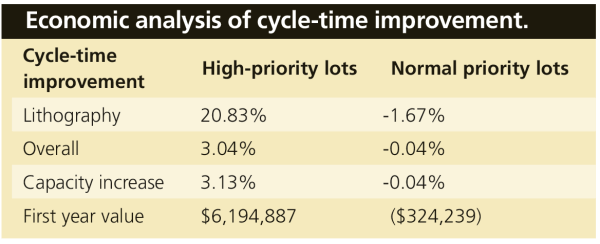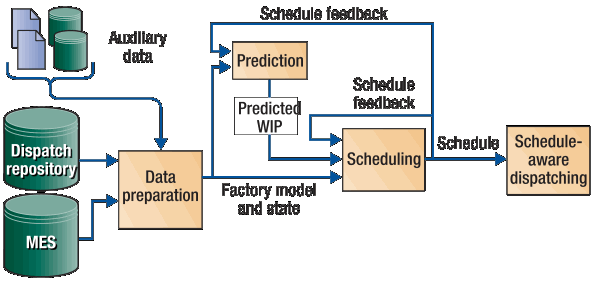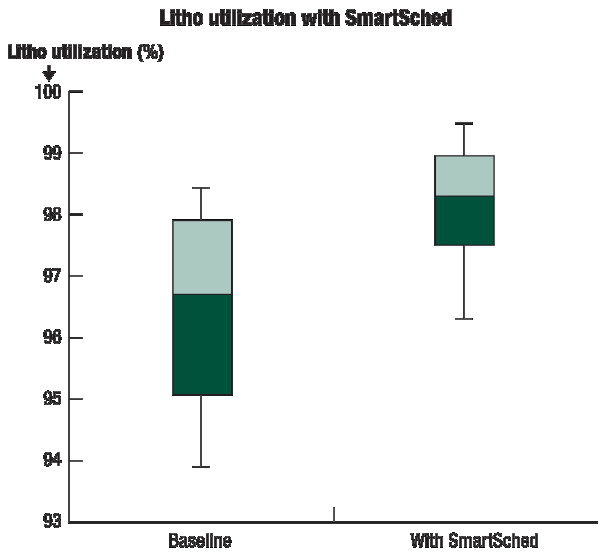|
Executive Overview There is a strong need to use optimization systems and processes to better match lots and tools, keeping litho tools fully utilized and reducing wafer cycle time. These benefits are realized by repeatedly creating new litho schedules based on the changing state of the fab. Prediction provides a snapshot of the future, allowing better lot grouping and increased tool utilization. |
Steve Marteney, Applied Materials Inc., Salt Lake City, UT USA
The Applied SmartSched integrates real-time dispatching (RTD) policies with locally optimized short-interval schedules to increase fab throughput and optimize litho tool utilization by converting ‘white space’ to available capacity. In essence, it produces an optimized schedule every few minutes that is executed by the RTD system. Its predictive techniques determine, for example, precisely where work-in-process (WIP) and reticles will be to efficiently process the WIP. This novel technology is now being deployed in lithography modules of production fabs; initial results show over 2% increase in litho wafers out and litho tool utilization improvements >1%.

System architecture
The technology is based on three key components (Fig. 1): real-time data generation, simulation-based prediction, and locally optimized short-interval scheduling.
 |
|
Figure 1. Key functional components and data flow to generate an optimized litho schedule. |
Real-time data generation and preparation. The data generation process imports detailed information from the fab’s manufacturing execution system (MES) and other automation data systems; this creates a normalized, detailed data model used to drive the behavior of prediction and scheduler components.
Prediction. The prediction process is a discrete-event simulation of the fab that forecasts WIP and its expected arrival at a specific step. Using detailed information about the changing state of the factory, prediction produces results that correspond to the loading of the fab: amount of WIP, state of equipment, scheduled PMs, product mix, etc.
Scheduler. The scheduler requires three main inputs: a detailed model of the state of the fab, predicted lot arrival times, and the previously generated schedule. It uses the real-time fab data to form litho scenario constraints in order to narrow down the schedule choices. Multiple optimized schedules are then created. The scheduling engine’s ‘objective function’ lets the user prioritize manufacturing tradeoffs based on key performance indicators (KPIs). It defines a cost for each schedule, so that schedules with a lower cost are more optimal. Common objective functions include the following: cycle time, lot-step due dates, move target, reticle moves, and stability (users quantify the tradeoffs between minimizing changes in the schedule and other objective functions). The resulting schedule includes lot-equipment assignments, lot processing orders, lot and reticle transport orders and a reticle inspection schedule.
Throughput and tool utilization increases
The new scheduler looks upstream and downstream to see WIP status in order to better plan and schedule work in the litho area. One common source of white space in litho occurs when WIP arrives at a tool, but the required reticle is not yet available. By looking ahead, the scheduling technology helps prevent a reticle from being "locked down" on one tool, when a less flexible tool using the same reticle could soon become idle. It further groups WIP better, increasing available capacity resulting in higher throughput. It has demonstrated a throughput improvement of 2.1% in a production litho module. One end user has used the software to achieve a >1% improvement in litho tool utilization (Fig. 2).
 |
|
Figure 2. End user data showing how litho utilization was boosted to greater than 1% by using SmartSched’s predictive scheduling. |
Cycle-time improvement
To demonstrate the effectiveness of the scheduler’s ‘objective function’ capabilities, we used 214 samples of production data to generate a production schedule; the same data was compared with pure heuristics-only real time dispatching. In this test, the software significantly improved cycle time for the highest priority lots by ~20% (Table 1), then improved the second highest priority lots by <5%. The cycle time for lower priority lots remained unchanged. This example verified that the ‘objective function’ capability in the scheduling component works and helps customers meet their KPIs, in this case, improving cycle time.
Conclusion
The advanced scheduling approach we have described is providing semiconductor manufacturers with improved results in critical photolithography areas. This solution also has the capability to schedule other critical fab production areas such as wet/diffusion with demonstrated KPI benefits, as well as has the potential to offer significant benefits for other industries, such as TFT-LCD manufacturing.
Steve Marteney earned his BS in electrical engineering from West Virginia U. and is a Senior Member of Technical Staff in the Automation Products Group at Applied Materials Inc., 5245 Yeager Road, Salt Lake City, UT USA 84116.
More Solid State Technology Current Issue Articles
More Solid State Technology Archives Issue Articles

